POLQ, or DNA polymerase theta, is an enzyme that plays a significant role in the DNA damage response (DDR), particularly in the repair of double-strand breaks (DSBs) through a process known as theta-mediated end-joining (TMEJ), which is also referred to as microhomology-mediated end-joining (MMEJ). It has emerged as a promising synthetic lethality target, especially in the context of cancers with deficiencies in homologous recombination (HR), such as those associated with mutations in BRCA1/2.
Interest in POLQ as a target for cancer therapy is driven by its potential to exploit the synthetic lethal interaction with HR-deficient cancers. Inhibition of POLQ in these cancer cells can lead to genomic instability and cell death, which forms the basis of its therapeutic strategy.
ICE Bioscience has constructed a cascade from in vitro to in vivo, comprising protein production, biochemical assays, cell line construction, cellular assays, and animal modeling. Our POLQ screening cascade empowers the mechanistic study of POLQ and ensures an efficient and comprehensive screening process for POLQ inhibitors, thereby accelerating the discovery of new drugs.
Assay List
▶ POLQ Protein Production
▶ Biochemical Assays:
1. POLQ ADP-Glo Assay (N-terminal)
2. POLQ Picogreen Assay (C-terminal)
3. POLQ TR-FRET Assay (C-terminal)
4. Selectivity Assay (Polα, Polγ, Polη, Polν, DNA binding)
▶ Cellular Assays:
1. Cell Proliferation Assay
2. NHEJ and HR Reporter Assays
3. Clonogenic Assay
4. γH2AX IFA and WB Assays
5. Drug Sensitive/Resistant Cell Line Generation
6. Cell Panel Screening
7. Western Blot for POLQ Degradation Detection
▶ In Vivo Efficacy Studies
POLQ is a large protein that contains three domains and is structurally and functionally distinct from other polymerases. The N-terminal domain contains a helicase-like ATPase domain that can unwind several types of DNA structures. The central domain binds RAD51, displaces RPA proteins from resected DSBs, and antagonizes HR repair in an ATP-hydrolysis-dependent manner. Finally, the C-terminal domain contains a nuclease domain that trims DNA ends and a polymerase domain that fills in nucleotides during MMEJ. Both the ATPase and polymerase domains are required for MMEJ repair.
For different experimental purposes, ICE Bioscience has separately expressed and purified the POLQ-N (M1-894) and POLQ-C (S1819-V2590) proteins.

a) The POLQ Helicase ATPase Enzymatic Assay leverages the N-terminal domain of POLQ, which exhibits helicase-like activity, to measure ATPase activity using the ADP-Glo assay.
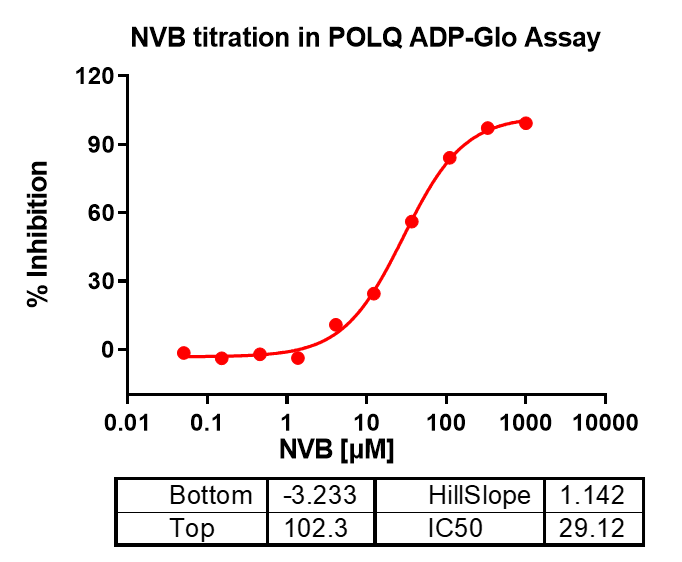
b) PicoGreen is a fluorescent nucleic acid stain that is highly specific for double-stranded DNA. It exhibits minimal fluorescence in the absence of DNA but shows a significant increase in fluorescence upon binding to dsDNA.

c) The C-terminal domain of the POLQ enzyme exhibits DNA polymerase activity, which is utilized to design dsDNA labeled with biotin. Upon enzymatic action, a nucleotide triphosphate (NTP) conjugated with a fluorescent tag becomes integrated into the dsDNA. In the presence of a detection reagent that binds to the dsDNA, a fluorescence resonance energy transfer (FRET) signal can be observed.

d) Leveraging the mechanism of TR-FRET, which capitalizes on the temporal separation of fluorescence emission to enhance the signal-to-noise ratio, we have developed assays for several additional targets within the polymerase family. These assays facilitate selective screening by enabling the specific detection of interactions or enzymatic activities associated with each target.
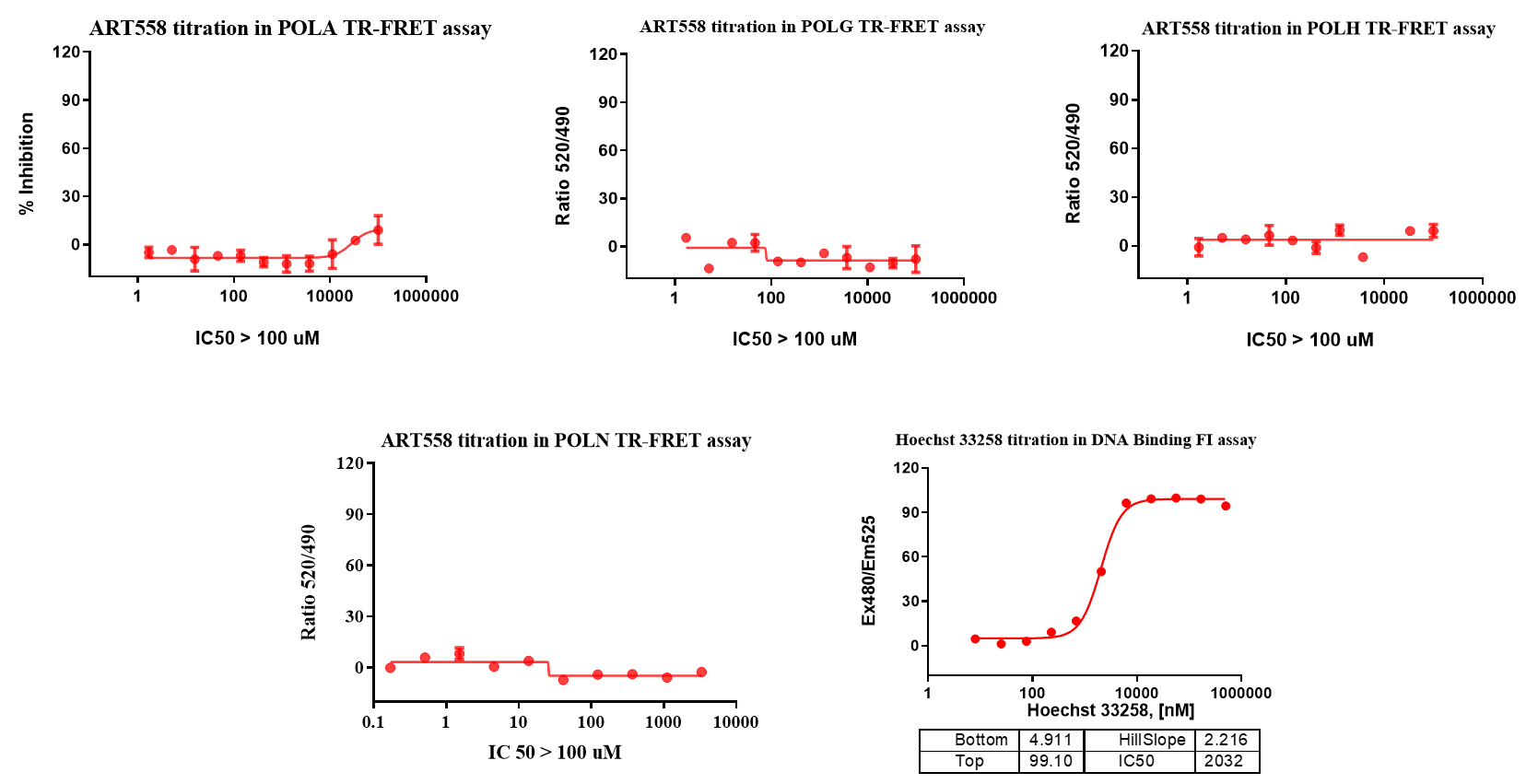
The DLD-1 BRCA2 KO cell line is a genetically engineered colon cancer cell line commonly used to study the loss of BRCA2, a key gene involved in homologous recombination repair. When BRCA2 is non-functional, cells are unable to effectively repair DNA double-strand breaks through HR, making them reliant on alternative repair pathways like MMEJ.
In this context, POLQ becomes critical, as it plays a central role in MMEJ. Inhibition of POLQ in HR-deficient cells, such as BRCA2-deficient ones, leads to genomic instability and cell death.
a) Cell Proliferation Assay
The purpose of a cell proliferation assay is to quantify the number of cells in a culture and monitor their growth rate over time. This assay provides valuable information on the viability, health, and expansion of the cell population, which can be influenced by experimental conditions, treatments, or the introduction of test compounds. By measuring cell proliferation, researchers can assess the cytotoxic effects of drugs, evaluate the efficacy of mitogens or inhibitors, and study the mechanisms of cell cycle regulation.

b) NHEJ and HR Reporter Assays
The NHEJ and HR Reporter Assays are key tools for evaluating the different DNA repair pathways involved in double-strand break repair. The NHEJ Reporter Assay assesses the NHEJ pathway, which repairs DSBs without requiring homology and is typically more error-prone. By comparing NHEJ and MMEJ activity, this assay helps determine the specificity of POLQ inhibition. Finally, the HR Reporter Assay evaluates the homologous recombination pathway, the most accurate form of DSB repair, providing insights into how cells compensate for HR deficiency through alternative mechanisms. Together, these assays offer a comprehensive view of DNA repair dynamics and the potential effects of targeting POLQ in cancer therapy.
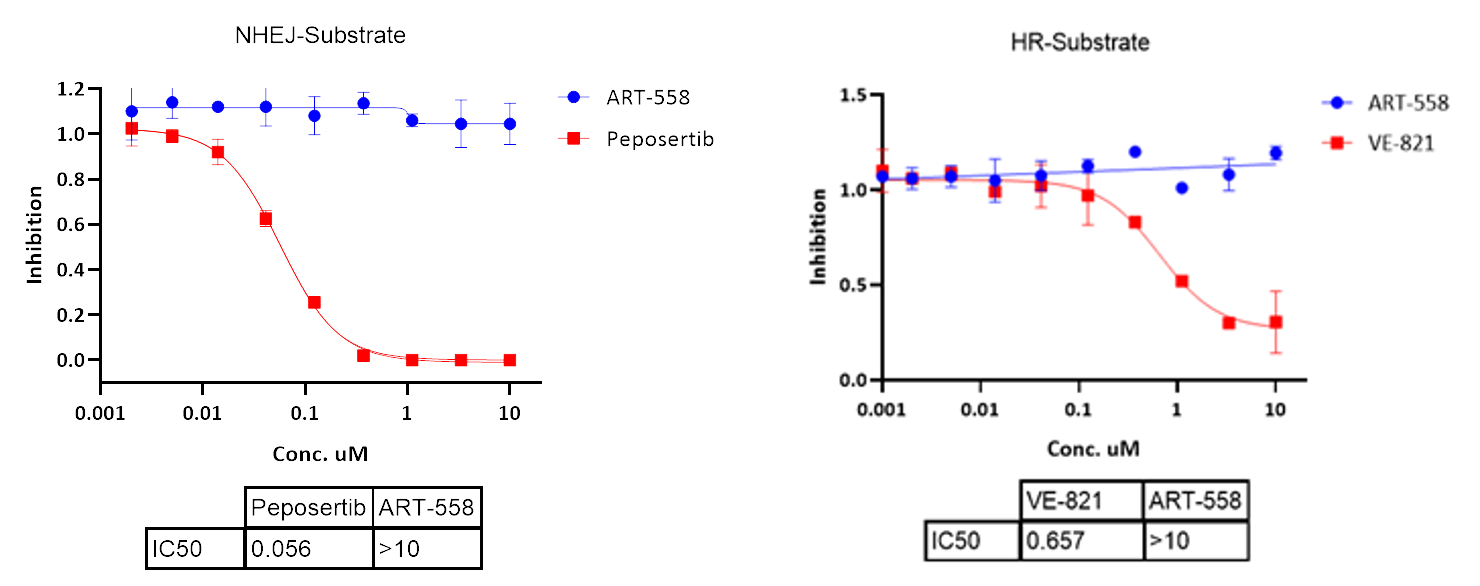
c) Clonogenic Assay
The clonogenic assay is designed to assess the ability of a single cell to survive, attach, grow, and divide to form a colony of progeny cells. By quantifying the number and size of colonies formed, we can infer the relative survival fraction of the cell population after treatment, providing valuable insights into the cytotoxicity or potential therapeutic applications of the agents being tested.
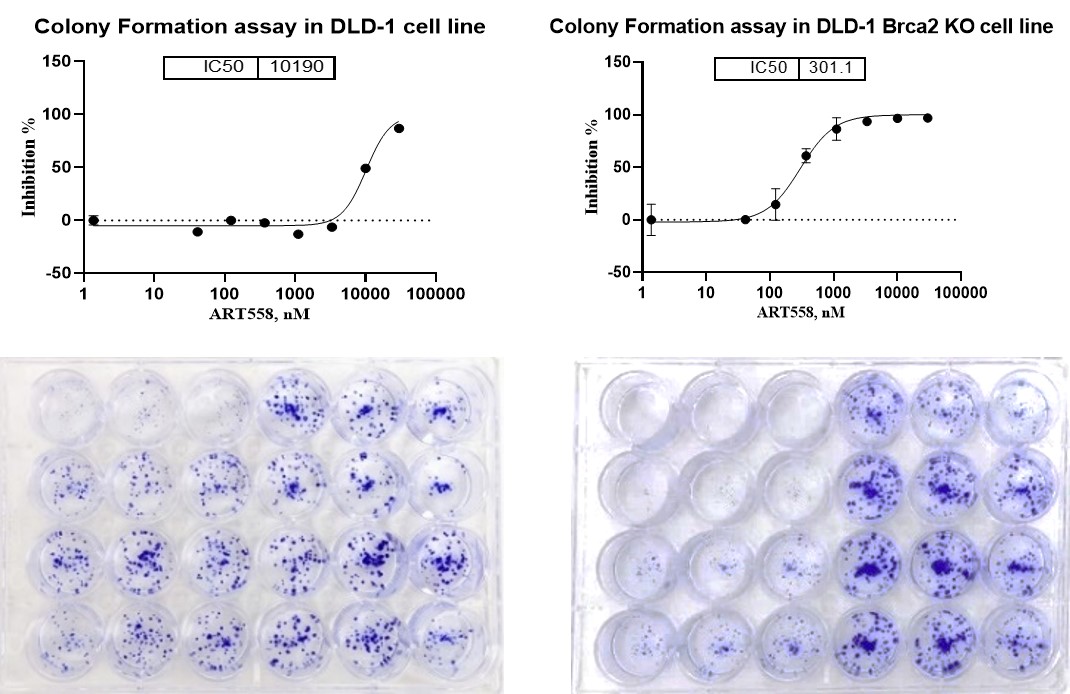
d) γH2AX IFA and WB Assays
γH2AX is a specific histone modification that serves as a marker for DNA double-strand breaks. When DNA is subjected to ionizing radiation or other agents that cause DSBs, the serine at position 139 of the histone H2AX is rapidly phosphorylated, resulting in γH2AX. This modification is crucial for the recruitment of DNA repair proteins to the site of damage and plays a role in the cellular response to DNA damage. The assessment of elevated γH2AX levels indirectly indicates the degree of DNA damage and the incidence of double-strand breaks.
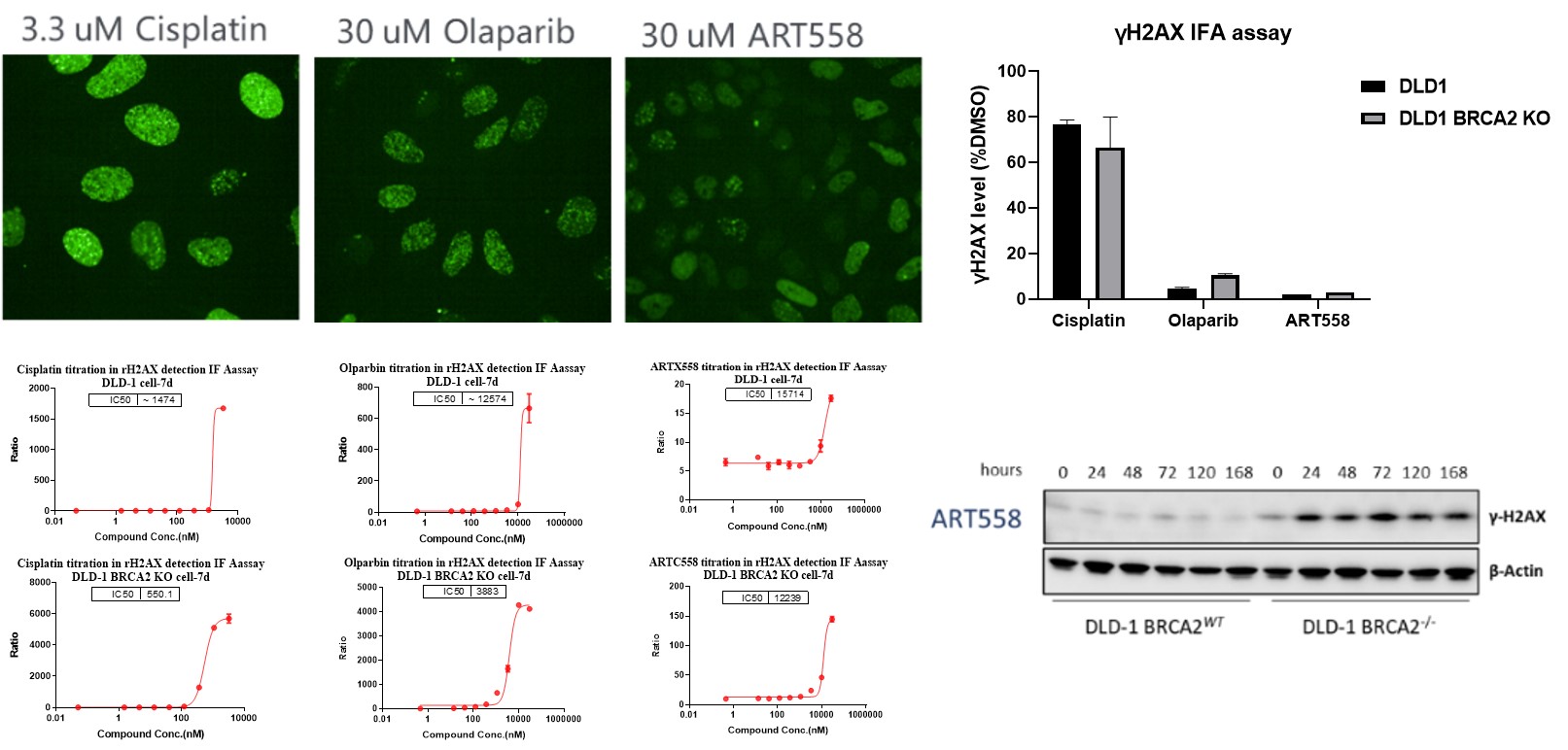
e) Drug Sensitive/Resistant Cell Line Generation
POLQ inhibitors are potentially effective in tumor cases that have become resistant to certain inhibitors. In light of this, we have developed corresponding resistant cell lines that facilitate the screening of POLQ inhibitors.

f) Cell Panel Screening
ICE Bioscience has a panel of 66 cell lines associated with various tumor types and DDR pathways. This panel is accessible for custom screenings, enabling the identification of cell lines that exhibit heightened sensitivity to inhibitors. This process is instrumental during the initial phase of compound screening or in the lead-up to IND application submission.

g) Western Blot for POLQ Degradation Detection
POLQ degradation can be effectively monitored using WB. ICE Bioscience has optimized the conditions for detecting POLQ, ensuring high sensitivity and specificity in this assay. This optimized WB protocol is particularly valuable for POLQ degrader screening, allowing precise quantification of POLQ levels. It is especially effective in BRCA2-deficient (BRCA2-/-) cell lines, making it an ideal model for evaluating the impact of POLQ degraders.
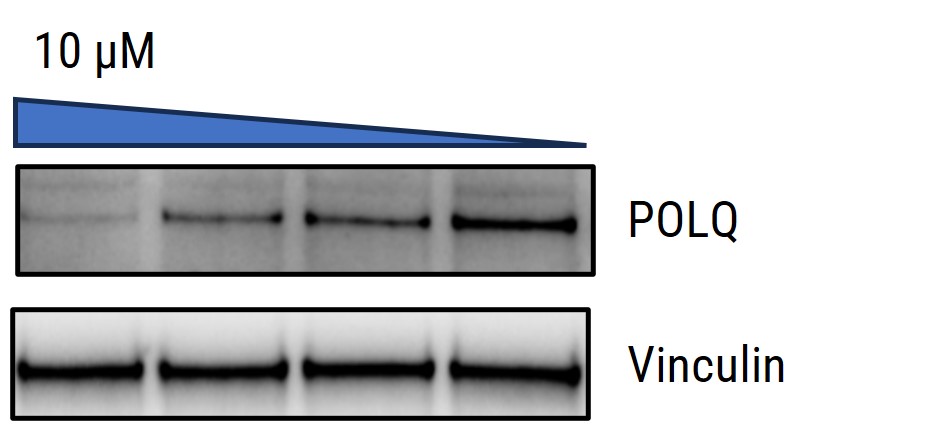
CDX models involve transplanting human cancer cell lines into immunodeficient mice, allowing for the study of human tumor growth in a living organism. Since the cell lines are well-characterized and maintained under controlled conditions, CDX models offer standardized and reproducible tumor growth, which is essential for assessing compound efficacy. To validate the therapeutic efficacy of POLQ inhibitors in vivo, we have developed CDX models with different cell lines to provide corresponding models for various indications.

Reference
[1]. Huang, R., Zhou, PK. DNA damage repair: historical perspectives, mechanistic pathways and clinical translation for targeted cancer therapy. Sig Transduct Target Ther 6, 254 (2021).
[2]. Luedeman, M.E., Stroik, S., Feng, W. et al. Poly(ADP) ribose polymerase promotes DNA polymerase theta-mediated end joining by activation of end resection. Nat Commun 13, 4547 (2022).
2025-10-30
2025-10-23
2025-09-28
2025-08-19
We value your inquiries and are here to provide you with tailored solutions for your drug discovery and development needs. Whether you have questions, require more information, or are interested in discussing potential collaborations, our team of experts is just a message away.
Feel free to reach out to us.